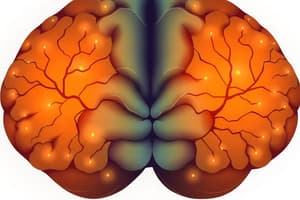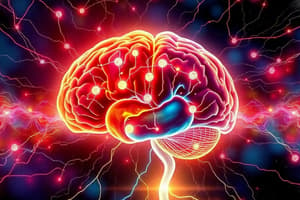Podcast
Questions and Answers
In the context of aging, which factor contributes to the increased risk of substance misuse?
In the context of aging, which factor contributes to the increased risk of substance misuse?
- Physiologic and sociologic changes (correct)
- Technological advancements
- Improved drug metabolism
- Increased physical activity
Which demographic primarily accounts for the 70% of alcohol-related deaths?
Which demographic primarily accounts for the 70% of alcohol-related deaths?
- Males (correct)
- Older adults
- Adolescents
- Females
What characterizes the early stages of substance dependence?
What characterizes the early stages of substance dependence?
- Users rely on the substance solely to feel normal.
- Users frequently consume substances without experiencing withdrawal.
- Social isolation and legal issues are common, but health declines are not evident.
- Tolerance develops, and users experience negative effects and mood swings. (correct)
During which stage of dependence do individuals often experience withdrawal symptoms and use substances to feel 'normal'?
During which stage of dependence do individuals often experience withdrawal symptoms and use substances to feel 'normal'?
Which statement about the late stage of substance dependence is accurate?
Which statement about the late stage of substance dependence is accurate?
Which personality traits are commonly associated with an addictive personality?
Which personality traits are commonly associated with an addictive personality?
What is a common behavioral change during the middle stage of substance use dependence?
What is a common behavioral change during the middle stage of substance use dependence?
Which statement accurately reflects the impact of alcohol on the central nervous system?
Which statement accurately reflects the impact of alcohol on the central nervous system?
What is often a consequence of relationships during the middle stage of substance dependence?
What is often a consequence of relationships during the middle stage of substance dependence?
What characterizes the late stage of substance dependence?
What characterizes the late stage of substance dependence?
What symptom is least likely associated with alcohol withdrawal syndrome?
What symptom is least likely associated with alcohol withdrawal syndrome?
Which statement about Fetal Alcohol Syndrome is incorrect?
Which statement about Fetal Alcohol Syndrome is incorrect?
Which statement accurately describes the effects of chronic alcohol use?
Which statement accurately describes the effects of chronic alcohol use?
What is the typical time frame for symptoms of delirium tremens to occur after cessation of alcohol use?
What is the typical time frame for symptoms of delirium tremens to occur after cessation of alcohol use?
Which electrolyte imbalance is commonly associated with heavy alcohol consumption according to its diuretic effect?
Which electrolyte imbalance is commonly associated with heavy alcohol consumption according to its diuretic effect?
Which physiological signs may indicate a patient is using methamphetamine?
Which physiological signs may indicate a patient is using methamphetamine?
What is an essential part of the detoxification care plan for an addicted patient?
What is an essential part of the detoxification care plan for an addicted patient?
What common misconception might lead to a false-positive drug screening result?
What common misconception might lead to a false-positive drug screening result?
Which intervention is NOT appropriate when caring for a patient with disorientation during detoxification?
Which intervention is NOT appropriate when caring for a patient with disorientation during detoxification?
What is the main purpose of disulfiram (Antabuse) in treating alcohol dependence?
What is the main purpose of disulfiram (Antabuse) in treating alcohol dependence?
Which of the following best describes the role of group therapy in substance abuse recovery?
Which of the following best describes the role of group therapy in substance abuse recovery?
What differentiates club drugs from other types of substances abused?
What differentiates club drugs from other types of substances abused?
What is a significant concern regarding the misuse of prescription medications?
What is a significant concern regarding the misuse of prescription medications?
In a treatment setting, why is family involvement considered important?
In a treatment setting, why is family involvement considered important?
What is one potential negative effect of chronic substance abuse on the limbic system?
What is one potential negative effect of chronic substance abuse on the limbic system?
What serious side effect is associated with the sudden withdrawal from barbiturates?
What serious side effect is associated with the sudden withdrawal from barbiturates?
What type of facility typically offers services focused on detoxification from substances?
What type of facility typically offers services focused on detoxification from substances?
What is the primary goal of treatment following detoxification?
What is the primary goal of treatment following detoxification?
What is a characteristic of flunitrazepam (Rohypnol) that contributes to its misuse?
What is a characteristic of flunitrazepam (Rohypnol) that contributes to its misuse?
What is true regarding the prescription history of benzodiazepines such as Valium?
What is true regarding the prescription history of benzodiazepines such as Valium?
What withdrawal symptom is typically experienced about 6 hours after the last dose of opioids like morphine or heroin?
What withdrawal symptom is typically experienced about 6 hours after the last dose of opioids like morphine or heroin?
What is the primary role of methadone in treating opioid addiction?
What is the primary role of methadone in treating opioid addiction?
Flashcards
Addiction Elements
Addiction Elements
Addiction involves excessive use/abuse, psychological distress, declining social/economic function, and uncontrollable consumption.
Alcoholism
Alcoholism
Addictive dependence on alcohol.
Multiple Addictions
Multiple Addictions
Individuals can have more than one addiction simultaneously.
Alcohol Use in Adults
Alcohol Use in Adults
Signup and view all the flashcards
Early Drinking and Alcoholism
Early Drinking and Alcoholism
Signup and view all the flashcards
Alcohol and Drug Abuse in Older Adults
Alcohol and Drug Abuse in Older Adults
Signup and view all the flashcards
Alcohol and Motor Vehicle Accidents
Alcohol and Motor Vehicle Accidents
Signup and view all the flashcards
History of Alcohol Use
History of Alcohol Use
Signup and view all the flashcards
Prohibition in the US
Prohibition in the US
Signup and view all the flashcards
Decline in Alcohol Use
Decline in Alcohol Use
Signup and view all the flashcards
Illicit Drug Use
Illicit Drug Use
Signup and view all the flashcards
Controlled Substance Act of 1970
Controlled Substance Act of 1970
Signup and view all the flashcards
Drug Enforcement Agency (DEA)
Drug Enforcement Agency (DEA)
Signup and view all the flashcards
Illicit Drug Use (2015)
Illicit Drug Use (2015)
Signup and view all the flashcards
Addictive Personality
Addictive Personality
Signup and view all the flashcards
Addictive Personality Traits
Addictive Personality Traits
Signup and view all the flashcards
Early Stage of Dependence
Early Stage of Dependence
Signup and view all the flashcards
Middle Stage of Dependence
Middle Stage of Dependence
Signup and view all the flashcards
Late Stage of Dependence
Late Stage of Dependence
Signup and view all the flashcards
Early Stages of Addiction
Early Stages of Addiction
Signup and view all the flashcards
Middle Stage of Addiction
Middle Stage of Addiction
Signup and view all the flashcards
Late Stage of Addiction
Late Stage of Addiction
Signup and view all the flashcards
Alcoholism as a National Problem
Alcoholism as a National Problem
Signup and view all the flashcards
Biological Causes of Alcoholism
Biological Causes of Alcoholism
Signup and view all the flashcards
Cultural Factors in Alcohol Use
Cultural Factors in Alcohol Use
Signup and view all the flashcards
Alcohol as a CNS Depressant
Alcohol as a CNS Depressant
Signup and view all the flashcards
Alcohol Absorption and Metabolism
Alcohol Absorption and Metabolism
Signup and view all the flashcards
Disulfiram (Antabuse)
Disulfiram (Antabuse)
Signup and view all the flashcards
Addiction Treatment
Addiction Treatment
Signup and view all the flashcards
Group Therapy
Group Therapy
Signup and view all the flashcards
Alcoholics Anonymous (AA)
Alcoholics Anonymous (AA)
Signup and view all the flashcards
Residential Treatment Center
Residential Treatment Center
Signup and view all the flashcards
Pain Management
Pain Management
Signup and view all the flashcards
Prescription Drug Abuse
Prescription Drug Abuse
Signup and view all the flashcards
Club Drugs
Club Drugs
Signup and view all the flashcards
Depressants (drugs)
Depressants (drugs)
Signup and view all the flashcards
Alcohol's Diuretic Effect
Alcohol's Diuretic Effect
Signup and view all the flashcards
Alcohol's Effect on Nutrition
Alcohol's Effect on Nutrition
Signup and view all the flashcards
Alcohol and Calories
Alcohol and Calories
Signup and view all the flashcards
Blood Alcohol Level (BAL)
Blood Alcohol Level (BAL)
Signup and view all the flashcards
Legal Blood Alcohol Limit
Legal Blood Alcohol Limit
Signup and view all the flashcards
Fetal Alcohol Syndrome (FAS)
Fetal Alcohol Syndrome (FAS)
Signup and view all the flashcards
Alcohol Withdrawal Syndrome
Alcohol Withdrawal Syndrome
Signup and view all the flashcards
Delirium Tremens (DTs)
Delirium Tremens (DTs)
Signup and view all the flashcards
Korsakoff Psychosis
Korsakoff Psychosis
Signup and view all the flashcards
Wernicke Encephalopathy
Wernicke Encephalopathy
Signup and view all the flashcards
Subjective Assessment (Substance use)
Subjective Assessment (Substance use)
Signup and view all the flashcards
Objective Assessment (Substance use)
Objective Assessment (Substance use)
Signup and view all the flashcards
Assessment in Substance Abuse
Assessment in Substance Abuse
Signup and view all the flashcards
Sedative-hypnotic abuse
Sedative-hypnotic abuse
Signup and view all the flashcards
Barbiturates
Barbiturates
Signup and view all the flashcards
Benzodiazepines
Benzodiazepines
Signup and view all the flashcards
Valium
Valium
Signup and view all the flashcards
Xanax
Xanax
Signup and view all the flashcards
Rohypnol
Rohypnol
Signup and view all the flashcards
GHB
GHB
Signup and view all the flashcards
Opioid analgesics
Opioid analgesics
Signup and view all the flashcards
Heroin
Heroin
Signup and view all the flashcards
Opioid overdose
Opioid overdose
Signup and view all the flashcards
Naloxone
Naloxone
Signup and view all the flashcards
Methadone
Methadone
Signup and view all the flashcards
CNS stimulants
CNS stimulants
Signup and view all the flashcards
Caffeine
Caffeine
Signup and view all the flashcards
CAGE Questionnaire
CAGE Questionnaire
Signup and view all the flashcards
Objective Data
Objective Data
Signup and view all the flashcards
Tremor/Skin Conditions (forearms)
Tremor/Skin Conditions (forearms)
Signup and view all the flashcards
Needle Tracks/Scabs
Needle Tracks/Scabs
Signup and view all the flashcards
MDMA (Ecstasy) Rash
MDMA (Ecstasy) Rash
Signup and view all the flashcards
Methamphetamine Use
Methamphetamine Use
Signup and view all the flashcards
Drug Use - Sniffling/Cough
Drug Use - Sniffling/Cough
Signup and view all the flashcards
Assessing Cognitive Abilities
Assessing Cognitive Abilities
Signup and view all the flashcards
Tachycardia/Hypertension
Tachycardia/Hypertension
Signup and view all the flashcards
Urine/Blood Drug Test
Urine/Blood Drug Test
Signup and view all the flashcards
False Positive Urine Screen
False Positive Urine Screen
Signup and view all the flashcards
Blood Test - Alcoholism
Blood Test - Alcoholism
Signup and view all the flashcards
Detoxification
Detoxification
Signup and view all the flashcards
Detoxification Environment
Detoxification Environment
Signup and view all the flashcards
Patient Airway Management
Patient Airway Management
Signup and view all the flashcards
IV Site Monitoring
IV Site Monitoring
Signup and view all the flashcards
Stimulant Abuse - Cardiorespiratory Distress
Stimulant Abuse - Cardiorespiratory Distress
Signup and view all the flashcards
Patient Communication
Patient Communication
Signup and view all the flashcards
Addiction Disease Concept
Addiction Disease Concept
Signup and view all the flashcards
Family Involvement
Family Involvement
Signup and view all the flashcards
Individual Therapy
Individual Therapy
Signup and view all the flashcards
Magnesium Sulfate
Magnesium Sulfate
Signup and view all the flashcards
Disorientation (night)
Disorientation (night)
Signup and view all the flashcards
Physical Restraints
Physical Restraints
Signup and view all the flashcards
Malnutrition in Addicted Patients
Malnutrition in Addicted Patients
Signup and view all the flashcards
Rehabilitation Goal
Rehabilitation Goal
Signup and view all the flashcards
Study Notes
Addiction: Key Elements and Stages
- Addiction components: Excessive use/abuse, psychological disturbance, decline in social/economic function, uncontrollable use (dependence).
- Multiple addictions: Possible to have more than one addiction simultaneously (e.g., alcoholism, smoking, gambling).
- Alcohol consumption: 87.4% of adults (18+) consumed alcohol in the past year; 6% have alcohol use disorder. Earlier drinking ages (14 or younger) correlate with higher alcoholism risk (44%). Alcohol abuse is increasing in older adults. Alcohol use and related deaths more common in males. Alcohol is a major factor in motor vehicle accidents.
Types of Substance Abuse
- Illicit drug use: 10% of US population reported illicit drug use in the prior month in 2015; marijuana was the most common. Federal drug laws were updated to better regulate drugs. The Drug Enforcement Agency (DEA) is the primary enforcer for these laws.
- Addictive personality traits: Low tolerance for stress, dependency, low self-esteem, insecurity, depression. It is unclear if these traits are present prior to addiction or are a result of it.
Stages of Dependence
- Early stages: Tolerance develops as use increases; physical symptoms appear (insomnia, anxiety, cramps); user might decrease or stop, but relapse is common; family/friends voice concerns, but user might deny issues, isolate themselves, or socialize with other users. Absenteeism problems at work/school, legal issues (DUI), and financial difficulties are present
- Middle stages: Moderate impairment; difficulties decreasing or stopping usage, followed by heavier use; withdrawal symptoms occur when substance use is stopped; user uses substance to maintain a "normal" state; deterioration of family/friend relationships, significant physical health issues (weight changes, GI problems, STIs), and job loss.
- Late Stages: Severe impairment in all areas of functioning; Nearly constant drug use to avoid pain; significant medical problems (liver disease, pancreatitis, malnutrition), neglect of personal hygiene; higher risk of HIV/Hepatitis B/C or other infections; suicidal/homicidal ideation, denial, manipulative behaviors, unemployment, homelessness.
Alcoholism: Etiology and Associated Disorders
- Prevalence: Alcoholism is a significant public health concern (second only to heart disease and cancer).
- Causes: Multifactorial; biological factors (genetic predisposition, enzyme deficiencies), and psychological theories are possible. Certain ethnicities (Asian, Native American, Inuit) have higher rates than the general population while others (Jewish, Mormon, Muslim) have lower rates.
- Fetal Alcohol Syndrome (FAS): Maternal alcohol consumption during pregnancy can cause severe birth defects like mental retardation, growth disorders, craniofacial abnormalities, and other birth defects as well as miscarriages and/or stillbirths. Even low levels of consumption can have adverse effects.
- Alcohol Withdrawal Syndrome (AWS): Occurs when alcohol use stops suddenly; risk factors include age, history of delirium tremens, malnutrition and other health conditions. symptoms range from mild to dangerous (seizures, hallucinations).
- Delirium Tremens (DTs): Serious complication of AWS caused by excessive alcohol consumption; associated high risk of death; symptoms are significant and severe.
- Korsakoff Psychosis and Wernicke Encephalopathy: Brain disorders from chronic alcoholism and vitamin B1 deficiency; symptoms include severe issues with short-term memory, disorientation, and possibly confabulation.
Nursing Process and Interventions
- Assessment: Includes subjective data (use patterns, last use), objective data (physical assessment, vital signs), and screening tools. Important to note past treatment/abstinence and possible co-occurring conditions.
- Diagnostic testing: Blood/urine screens for substances, liver enzymes, nutrient levels (B vitamins, magnesium).
- Patient problems: Address emotional and physical needs.
- Detoxification: Safe supervision in a controlled environment.
- Rehabilitation: Focuses on abstinence, address individual issues, and involves family support. Tools such as Alcoholics Anonymous and 12-Step programs, residential treatment centers, individual and group therapy are common.
Drug Abuse: Types and Consequences
- Prescription and OTC drug abuse: Significant threat; involves misuse or abuse of prescribed/non-prescribed drugs for non-medical reasons.
- Club/street drugs: Commonly abused (cocaine, amphetamines, hallucinogens). Causes various side effects and potential for severe dependence.
- Depressants: Alcohol, sedative-hypnotic medications, opioid analgesics (barbiturates, benzodiazepines, etc.); tolerance/dependency is common including withdrawal issues.
- Opioid analgesics: Abuse frequently; symptoms include respiratory depression, pinpoint pupils, stupor/coma. Withdrawal can be extremely difficult.
- Stimulants: Caffeine, nicotine, cocaine, amphetamines, etc. Short-term and potentially devastating long term effects; severe dependence is possible. Withdrawal symptoms include craving, agitation, and depression.
- Hallucinogens: PCP, LSD, MDMA, ketamine, mescaline, psilocybin; altering perceptions and thoughts, sometimes severe symptoms and psychological issues from severe use
- Cannabis: Marijuana, concentrated resin; side effects include distorted perception, difficulty with problem-solving/memory/learning. Chronic use may result in several physical and psychological issues.
- Inhalants: Solvents, glues, aerosols, refrigerants; possible severe and/or irreversible brain/organ damage.
Chemically Impaired Nurses:
- Prevalence: Estimates indicate a substantial prevalence of addiction in nurses.
- Warning signs: Many of the general warning signs of substance abuse also apply to nurses. Includes changes in work habits, documentation, or interactions with patients and colleagues, as well potentially requiring to work shifts that improve access to substances.
- Impact: Can put patients at risk for injury, medication errors, slower recovery.
- Reporting: The role of colleagues in reporting is crucial; anonymous reporting is often possible. Use of a journal for observations is necessary for recollection later.
- Treatment and support: Referral to state-operated peer assistance programs can provide support and treatment while maintaining professional license.
Studying That Suits You
Use AI to generate personalized quizzes and flashcards to suit your learning preferences.




